It’s well known that animal dung is generally a good fertilizer. Of course, too much of a good thing begins to turn on you. But, when managed well, animal manure is amazing for soil. What is not so well known is that humanure is good for the land as well.
Regenerative Human Waste … Manure
We get fearful because of the various diseases we can get from humanure in particular. But, rightly handled, it becomes a very nutrient rich fertilizer. And human urine is perfectly fine directly on the ground, as long as it doesn’t get too concentrated.
With urine, there is little concern. Urinating in one location repeatedly can cause issues, both on top of and in the soil. And, of course, there are issues that have to be dealt with to help avoid other possible contagions and illness.
Where privacy is an issue, a simple toilet can be set up that flushes into a small catchment that allows the diluted urine to settle into the ground and be filtered by vegetation, usually reeds, grasses and flowers.
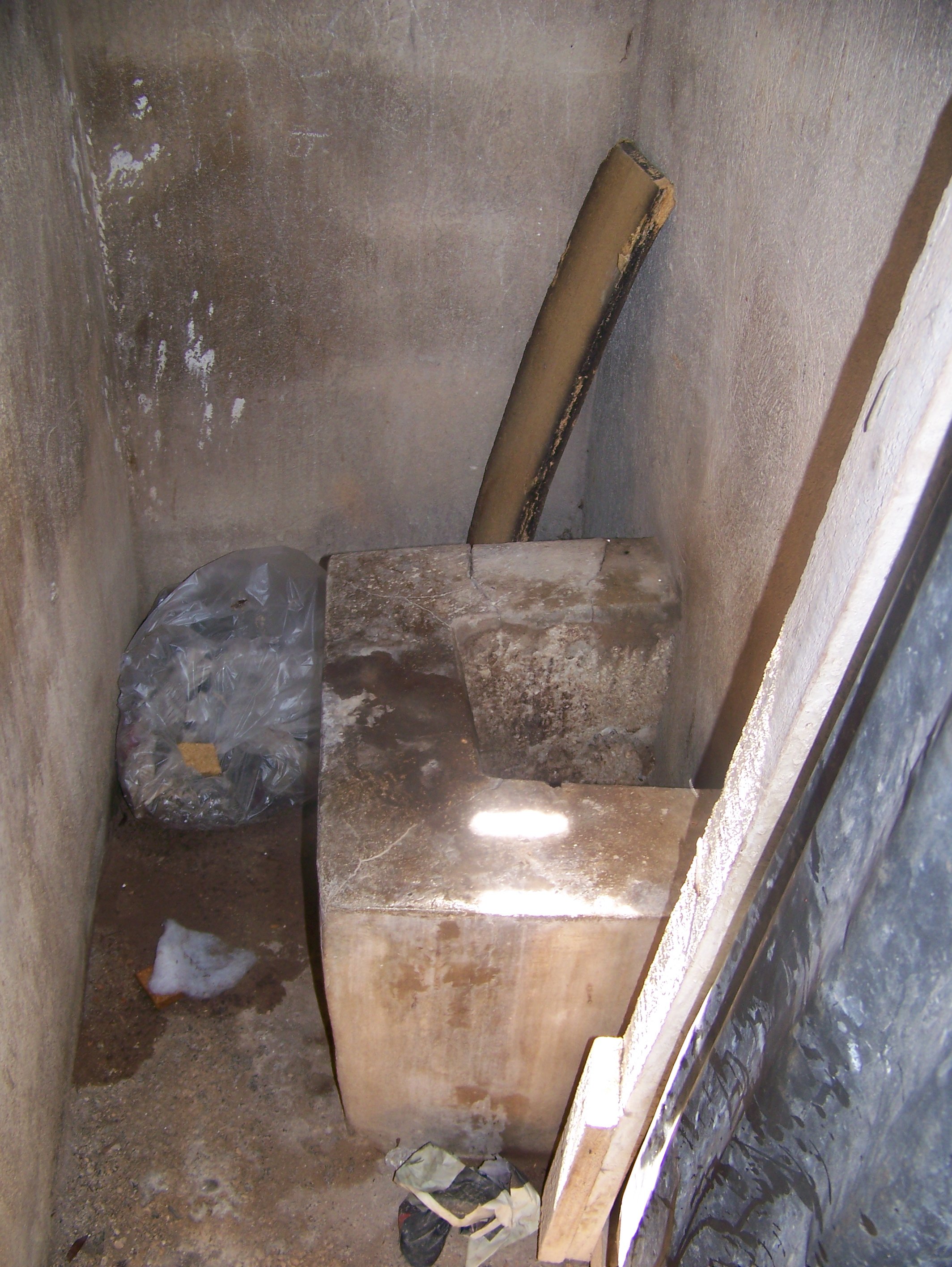
This is the latrine at the church where the school is.
For humanure, there are a few options. One is to simply compost it, where the container below the toilet is kept relatively dry by covering all dung with moss, shavings, sawdust or other relatively fine and absorbent organic material. By keeping it covered, the stench is absorbed and the dung begins breaking down in a healthy fashion.
Once a bin is full, it is then sealed and set to sit, preferably for a full year. After a year it can be used, but often it’s better to add it to an existing compost system to further decompose.
Apparently one organization in the area would like to pursue this model on the island. Up to this point, I’m not aware of any on La Gonâve.
Another method is pretty common, which is to simply dig a hole in the ground over which the toilet sits. It too is a non-flush system. And, like the composting system above, all dung should be covered immediately. Once it’s full, it’s simply a matter of removing the outhouse, covering the hole and digging another hole to set the outhouse over.
My favorite option is the biodigester, also known as a biogas unit. You can read details about how to build one in this PDF. It’s a very simple method of using anaerobic composting to break down the humanure in such a manner that captures the methane for fuel and produces a liquid byproduct that could be fit for watering a vegetable garden, but is generally put through an aerobic system before leaching out into a garden area. These are even more effective if additional manure is added, such as pig or cow dung.
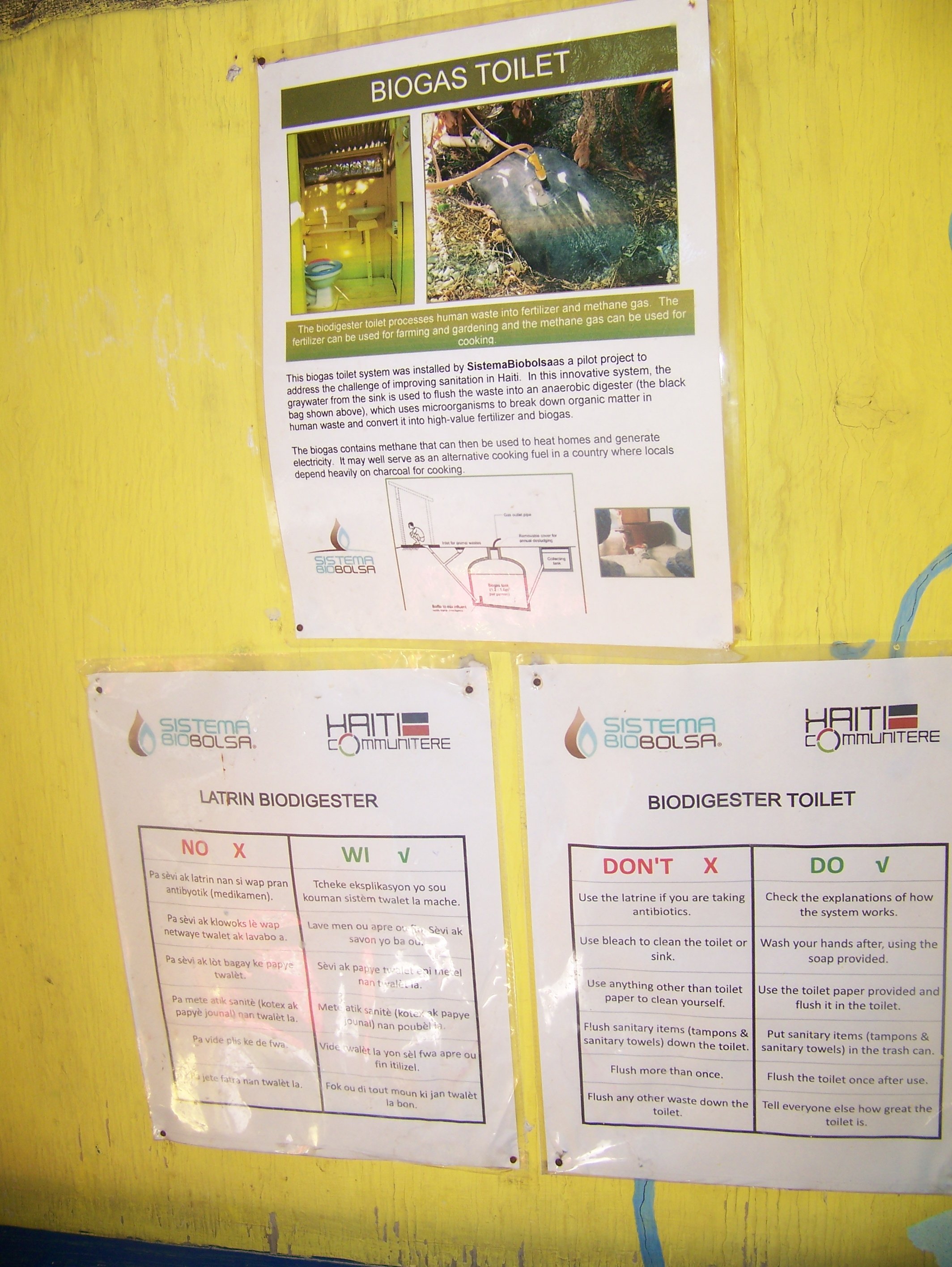
I’ve seen one in action, at Haiti Communitere – a small compound in Port au Prince that uses resilient sustainable methods as a representation of what can be accomplished. You can stay there for a reasonable fee too, as Jean Rony and I did when I was returning from my trip. It’s really simple in design, and completely odorless.
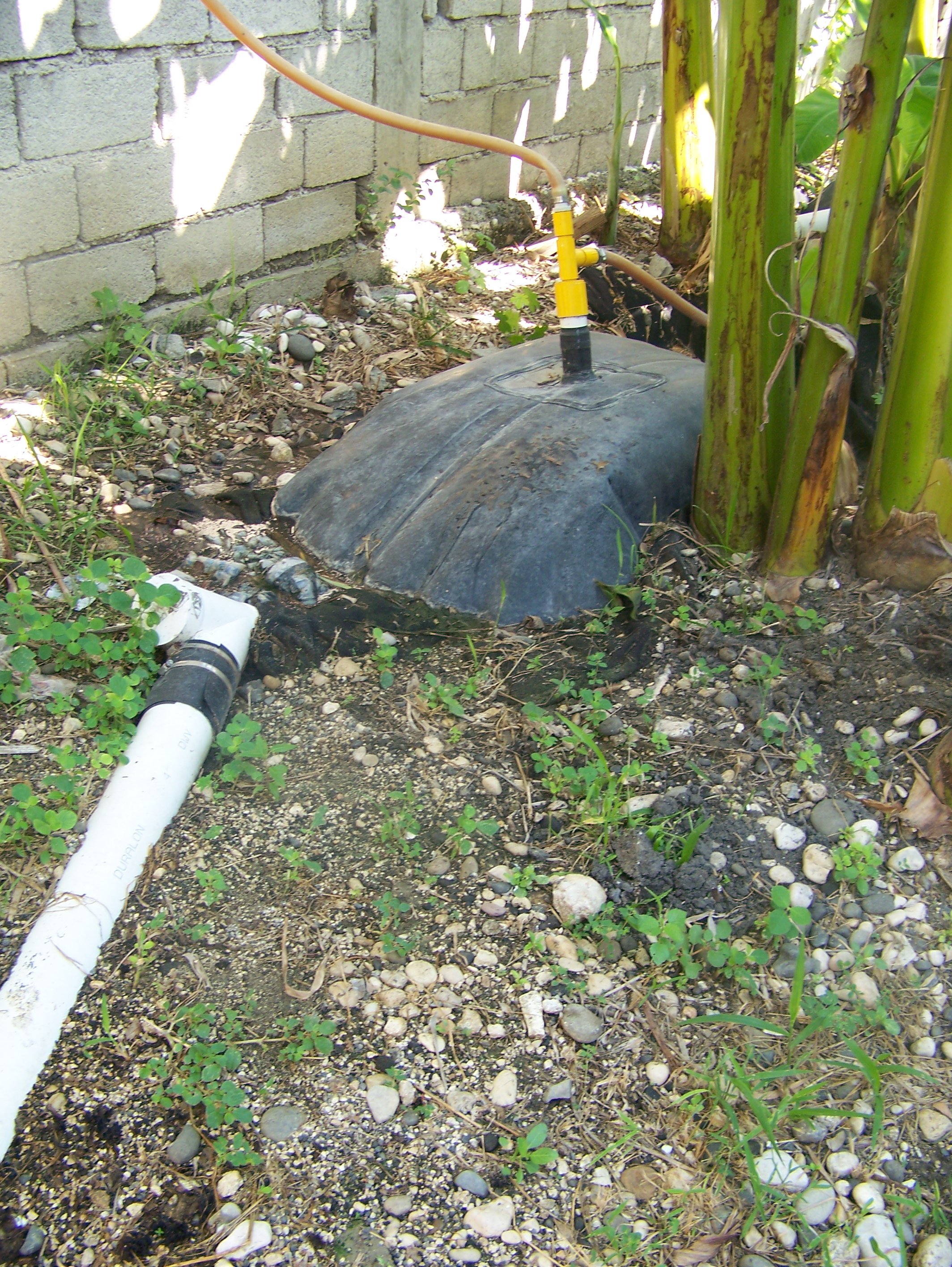
For a quick rundown, the toilet flushes waste into a septic tank that is either a bladder or has a bladder at the top, so it can expand as gasses build up. At the top of the bladder is a gas line that goes through a couple of filters, including a condenser, before reaching a stove designed to use low pressure methane. The waste produces a liquid byproduct, as I mentioned above. The solids build up very slowly and will have to be removed years later. By that time they’re so decomposed that they too can be used as fertilizer.
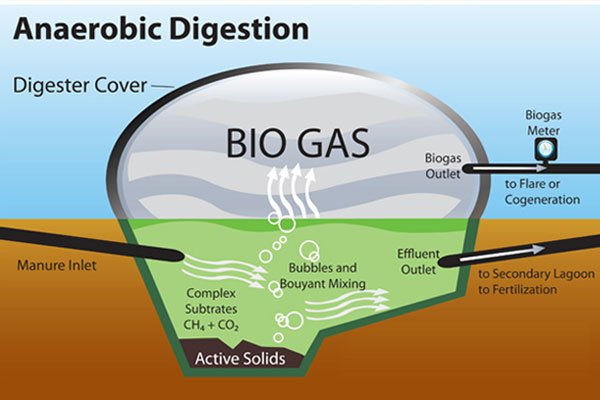
What we like about the Puxin unit is that it is built with reusable forms that make the job very simple. Some cinderblocks can be used at the base (or concrete), then the rest is done with concrete. It’s very inexpensive to build and generally maintenance free, other than normal cleaning and the need to empty it every few years. With one set of forms and some training, these could be set up all over the island. In such a system, cholera is no longer an issue.
Incidentally, there was a huge cholera outbreak on mainland Haiti after the earthquake. By tracing the specific strain of cholera, it is possible to narrow down the exact location it is entering the waterway. However, for some reason this one was difficult to find. As it turns out, it was being covered up because the source was a UN facility. If you care to research it, here’s an article to get you started. It’ll be no surprise to see Clinton’s name involved. Composting destroys cholera and the various disease causing pathogens associated with human dung.
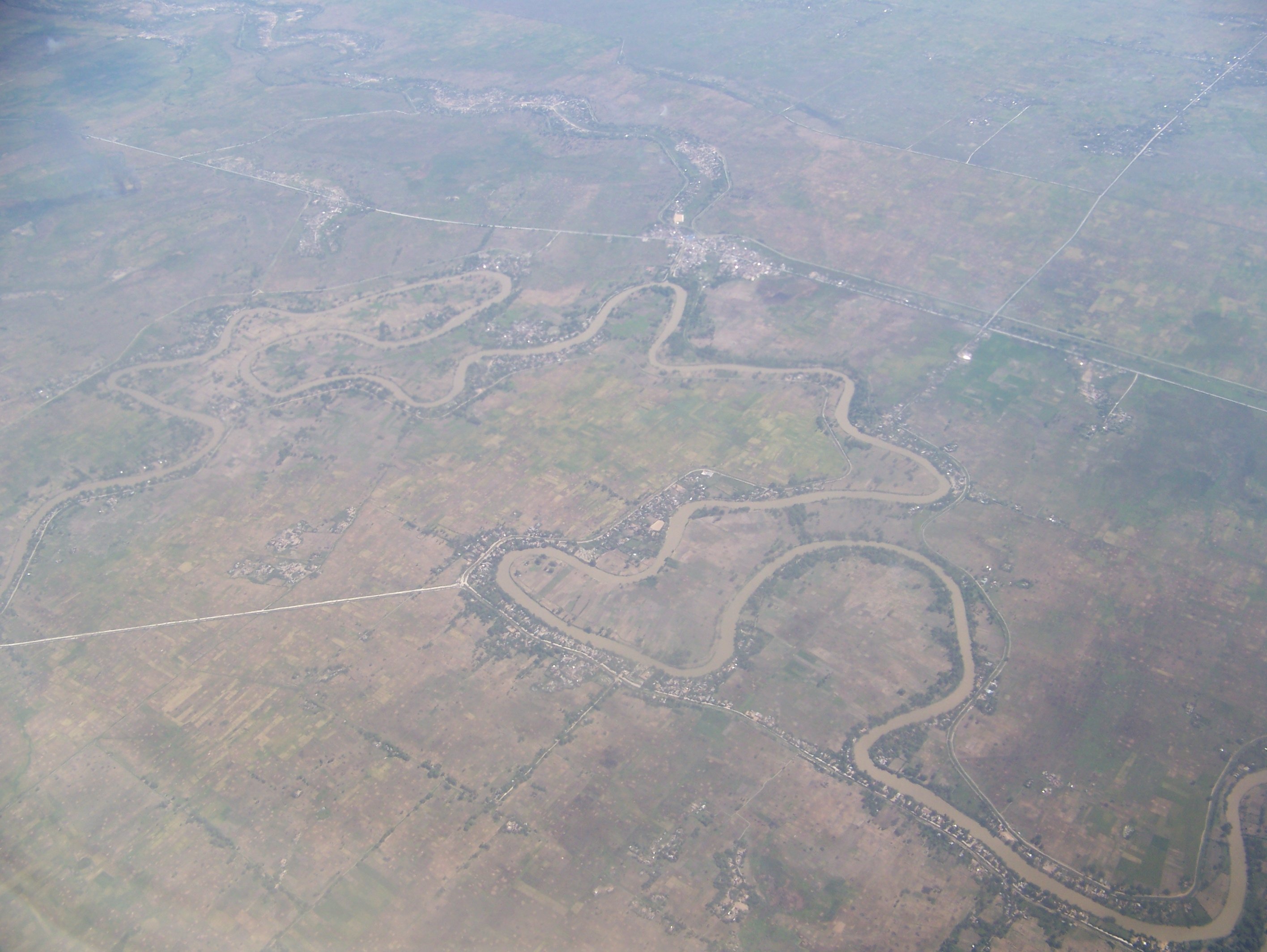
The river acts as a cholera distribution system.
Compost EVERYTHING
All other organic waste should either be spread on the ground as litter, or incorporated into a composting routine. The greater amount of compost, the better, since it tends to feed upon itself. There are precautions that must be taken, such as avoiding combustion if the system gets too hot. But this is one of the most productive means to get organic material and nutrients into our soils. And these systems can almost always be placed strategically in the project to maximize nutrition and efficiency.
As a note, a healthy compost system, whether it includes manure or not, does not stink. If it stinks, then it’s too wet and needs more dry matter. If it’s not getting hot enough to decompose well, then just add more green material or water to encourage the reaction in the compost, raising the temperature. An ideal temperature is about 140 F.
You’d be surprised how hot these can get. Some people have run water lines through their compost heaps in order to provide their hot water. Others have put them on the side of their buildings or greenhouses in cold climates to share the heat they produce. It really works.
Carbon Sequestering
Regardless of where one stands on the global warming issue, it is a known fact that the sequestering of carbon in the soil is good for the soil. So, even if you don’t subscribe to the whole man-caused global warming idea, you can recognize the value of these techniques for building up soil carbon.
If you do buy into global warming as influenced by man, then you will be encouraged by projects like this. As Joel Salatin points out, if farmers would pursue these sorts of practices, within ten years we could sequester more carbon than has been released into the atmosphere since the beginning of the industrial revolution. That’s pretty amazing regardless of your perspective.
Until Tomorrow
Hopefully that helps to promote a vision in your mind’s eye of what can be done on La Gonâve. I can’t stress enough how effective this can be in completely changing the dynamic of the island’s ecology, as well as the lives of its inhabitants. This isn’t some pipe dream or mere supposition. It’s being done in various places around the world today.
Perhaps my favorite example is in Brazil, where Ernst Götsch used the rainforest as a model for establishing an amazing agro-ecological project on degraded land. The results are quite amazing, going so far as to affect, not only the climate of the property regenerated, but also the climate of neighboring properties around the project. As you watch Life in Syntropy (below), you’ll see exactly why I get so excited about this and why I am so confident this can be done on La Gonâve.
This CAN be done on La Gonâve. But it will require some funding, hard work and establishing a vision for the land owners so that they’ll be ready to cooperate in its pursuit. The results could be staggering.
We’ll discuss this in the second-to-last entry of this series tomorrow, as we reflect on what it would take to promote the landowners and protect them from those who would predate on a poor people who have access to productive land.
Steemin' on,
Another Joe

Email notifications
Facebook
Twitter



